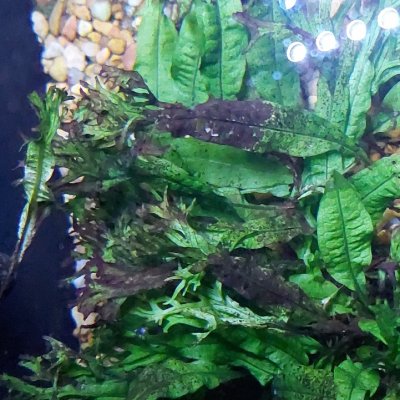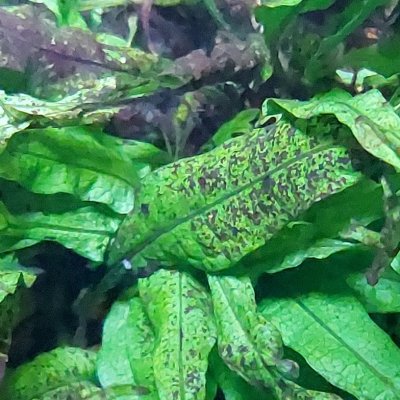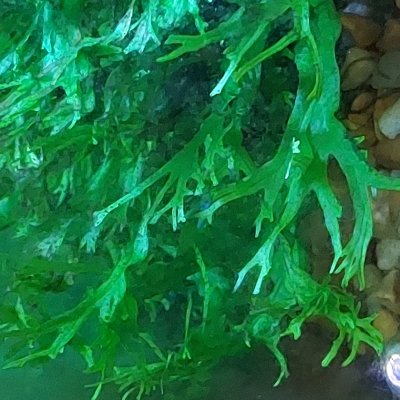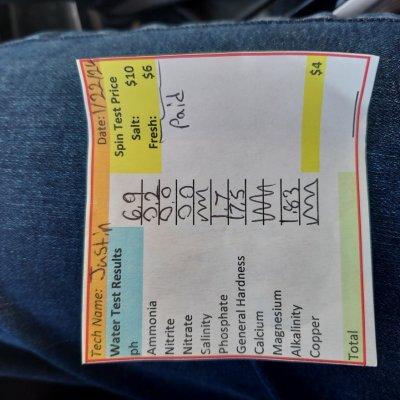My plants don't look healthy. But they don't look like any of the pictures online. There is no yellowing or pin holes or dark veins or whatever might indicate something specific. Some parts look healthy. Some parts have big chunks of black. It is a 10 gal tank with 3 brilliant rasboras.
You are using an out of date browser. It may not display this or other websites correctly.
You should upgrade or use an alternative browser.
You should upgrade or use an alternative browser.
Please help my plants
- Thread starter chenyi
- Start date
The friendliest place on the web for anyone with an interest in aquariums or fish keeping!
If you have answers, please help by responding to the unanswered posts.
If you have answers, please help by responding to the unanswered posts.
How long have you had the plants?
Does the black stuff rub off?
Do you know what your water parameters are?
Does the black stuff rub off?
Do you know what your water parameters are?
Nitrate?
Id also check and see if you can a check on phosphates too. Either from your water company or a test of your water.
Id also check and see if you can a check on phosphates too. Either from your water company or a test of your water.
Last edited:
Well. Your nitrate is too low for a planted tank and will be causing nutrient deficiencies. You ideally want it up towards 20ppm. On the other hand your phosphate is too high and really wants to be below 1ppm or it will be feeding algae. Not really sure how to correct the nitrate without also raising phosphate levels.
Is that a test on your tank water or your tap water?
Is that a test on your tank water or your tap water?
$6 for a water test. You dont need to do many of those before you may as well just buy the test kit.
Well, I sort of had a little success for a while. I bought some RO water and mixed that in 50%. Lo and behold, a lot of the algae magically cleared up and all my water lettuce started to look healthier and started to grow little baby leaves. I thought it was due to the hardness, so I got a hardness test kit and I went back to tap water. Now my plants are doing badly again. The hardness doesn't seem to be the problem. I dunno. But I am going to try running the RO water mix for a couple of months and see if that really fixes it. But I still want to get to the bottom of it.
Going back to your water test results, your alkalinity/ carbonate hardness is very low, so mixing tap water with RO will make it even softer. Plants tend to do better with higher KH.
True. On my second water change I added some making soda. But it was doing better even before that.Going back to your water test results, your alkalinity/ carbonate hardness is very low, so mixing tap water with RO will make it even softer. Plants tend to do better with higher KH.
So I decided to go back to the tap water, but I went nuclear on it. I did 100% water changes daily and I did Flourish and Flourish nitrogen and Flourish Excel and Prime. I measured all the chems with a pipette and I was totally OCD about it. Sure enough! The plants started to grow again. The roots on the water lettuce got much thicker and I got new leaves forming on the water lettuce and the anubias. Then I got lazy. I kept doing the chems, but the water changes all the time were too much of a pain in the butt. Unfortunately, guess what. My plants started dying again. The water lettuce roots thinned out and they got lots of little pinholes in the leaves. The directions for the Excel say to do 1ml/day or 5ml if you had done a major water change. Since I was doing major water changes every day, I was doing 5ml of Excel every day. So when I cut back on the water changes, I also cut back on the Excel. So now I'm thinking maybe that is the problem. Maybe I need to add more carbon. The Excel specifically says "DO NOT OVERDOSE". So, I think I should not do that. Maybe I need a CO2 system after all. Or maybe there is something else in the water that is rapidly getting used up?
The problem with doing a whole heap of changes at once is that you dont know which change had the positive or negative effect. Your positive change could have been due to the fresh water, or any one of the ferts you used. When you stopped the frequent water changes your positive changes also stopped though.
The method really is to change one thing at a time, then observe your plants over a number of weeks to give that change time to have any positive or negative effect. That way you know the thing you changed had that effect, be it positive or negative. Continue with whatever has a positive effect, revert back if you see negative effects. Then change something else and observe whether that change is positive or negative.
The reason i said planted tanks do better in harder water is because those low nutrient demand plants that most people keep in aquariums get their carbon from carbonate hardness (KH) rather than CO2. As said your KH (Alkalinity on your testing) is very low and the plants will use that up quickly. Your water changes would have been frequently replenishing that KH, with the baking soda getting it higher too. You havent mentioned if you continued with dosing baking soda or not, or what that brought your KH up to.
I would be very careful with Excel. The active ingredient in Excel and Excel like products is gluteraldhyde. The main use of gluteraldhyde is to sterilise medical equipment, and if you carefully read all the paperwork for Excel it will say something along the line of "harmful to marine life" which is a bit of a clear warning for a product intended for use in aquariums. What gluteraldhyde does in aquariums is act as a mild algaecide, and will clean the leaves of plants a little, so they are better able to get at available carbon in the water. The chemical reaction it goes through uses up a lot of oxygen from the water. A common use of excel is to double dose to clear up black beard algae, and a common outcome is all the fish die from oxygen depletion. Be very careful to not overdose, and consider if the dubious benefits are worth the risk. The science behind Seachems claim that it provides carbon is very thin, but they are very good at marketing.
The method really is to change one thing at a time, then observe your plants over a number of weeks to give that change time to have any positive or negative effect. That way you know the thing you changed had that effect, be it positive or negative. Continue with whatever has a positive effect, revert back if you see negative effects. Then change something else and observe whether that change is positive or negative.
The reason i said planted tanks do better in harder water is because those low nutrient demand plants that most people keep in aquariums get their carbon from carbonate hardness (KH) rather than CO2. As said your KH (Alkalinity on your testing) is very low and the plants will use that up quickly. Your water changes would have been frequently replenishing that KH, with the baking soda getting it higher too. You havent mentioned if you continued with dosing baking soda or not, or what that brought your KH up to.
I would be very careful with Excel. The active ingredient in Excel and Excel like products is gluteraldhyde. The main use of gluteraldhyde is to sterilise medical equipment, and if you carefully read all the paperwork for Excel it will say something along the line of "harmful to marine life" which is a bit of a clear warning for a product intended for use in aquariums. What gluteraldhyde does in aquariums is act as a mild algaecide, and will clean the leaves of plants a little, so they are better able to get at available carbon in the water. The chemical reaction it goes through uses up a lot of oxygen from the water. A common use of excel is to double dose to clear up black beard algae, and a common outcome is all the fish die from oxygen depletion. Be very careful to not overdose, and consider if the dubious benefits are worth the risk. The science behind Seachems claim that it provides carbon is very thin, but they are very good at marketing.
Yeah, definitely makes sense to do one change at a time. But I just want my plants to not be an embarrassment in the meantime. So I didn't care - as long as I could get something working. Then I could drop stuff until I found what made a change. That's sort of what I did. It was more out of laziness, but I stopped doing the daily water changes and that made a difference. The annoying thing is it takes so long to actually see a change!!! The water lettuce responds quicker and it doesn't rely on the substrate so much. Adding that was smart. It is a good indicator.The problem with doing a whole heap of changes at once is that you dont know which change had the positive or negative effect. Your positive change could have been due to the fresh water, or any one of the ferts you used. When you stopped the frequent water changes your positive changes also stopped though.
The method really is to change one thing at a time, then observe your plants over a number of weeks to give that change time to have any positive or negative effect. That way you know the thing you changed had that effect, be it positive or negative. Continue with whatever has a positive effect, revert back if you see negative effects. Then change something else and observe whether that change is positive or negative.
The reason i said planted tanks do better in harder water is because those low nutrient demand plants that most people keep in aquariums get their carbon from carbonate hardness (KH) rather than CO2. As said your KH (Alkalinity on your testing) is very low and the plants will use that up quickly. Your water changes would have been frequently replenishing that KH, with the baking soda getting it higher too. You havent mentioned if you continued with dosing baking soda or not, or what that brought your KH up to.
I would be very careful with Excel. The active ingredient in Excel and Excel like products is gluteraldhyde. The main use of gluteraldhyde is to sterilise medical equipment, and if you carefully read all the paperwork for Excel it will say something along the line of "harmful to marine life" which is a bit of a clear warning for a product intended for use in aquariums. What gluteraldhyde does in aquariums is act as a mild algaecide, and will clean the leaves of plants a little, so they are better able to get at available carbon in the water. The chemical reaction it goes through uses up a lot of oxygen from the water. A common use of excel is to double dose to clear up black beard algae, and a common outcome is all the fish die from oxygen depletion. Be very careful to not overdose, and consider if the dubious benefits are worth the risk. The science behind Seachems claim that it provides carbon is very thin, but they are very good at marketing.
I did not continue with the baking soda because it affected the pH so much. The KH of my tap water is 2. I understand that is low, but that is what I have been using and it has been working. It's not ideal, but it isn't the biggest problem.
I tried to find some info on the use of KH vs CO2 by low nutrient demand plants. I can't really find that. Everything seems to say CO2 is the low hanging fruit and KH is more of a last resort as a carbon source. I'm not sure. With the water lettuce, it could get CO2 from the air as well - so I'm not sure what the daily water changes are bringing to the table, but I'm pretty sure they are doing something.
Very, very interesting info on the Excel. Thanks for that. I will be careful. I thought it was settled science.
Similar threads
- Replies
- 3
- Views
- 902
- Replies
- 11
- Views
- 861
- Replies
- 3
- Views
- 418
- Replies
- 3
- Views
- 819




